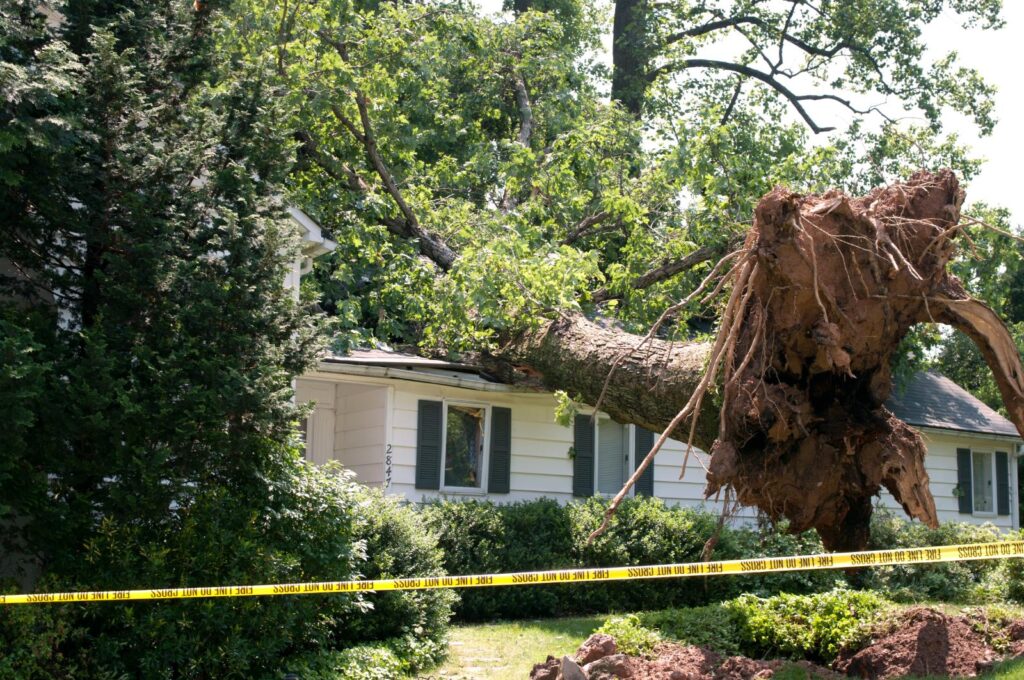
Contents
When a storm hits, quick damage cleanup action is vital for effective cleanup. Start by evaluating the damage to identify hazards like downed power lines or unstable structures. Safety should always come first, so don’t forget to wear protective gear. With the right tools and techniques, you can mitigate further damage and set the stage for recovery. Let’s explore the essential steps you need to take to tackle the aftermath efficiently.
Key Takeaways
- Assess and document all damage types, including structural, water, and wind, for insurance purposes.
- Wear protective gear and evaluate the area for hazards before starting cleanup.
- Use heavy-duty trash bags for debris collection and a shovel for larger debris removal.
- Quickly remove water using submersible pumps, wet/dry vacuums, and mops to prevent further damage.
- Implement preventive measures like storm-resistant landscaping and regular roof inspections to mitigate future damage.
Assessing the Damage
When evaluating the damage after a storm, it’s essential to act quickly to guarantee safety and prioritize recovery efforts.
Start by identifying the damage types, which can include structural, water, and wind damage. Each type requires a different approach in your damage assessment.
As you inspect your property, look for visible signs of harm—cracked walls, leaking roofs, or fallen trees.
Don’t forget to check your outdoor areas, as debris can pose hazards. Document everything with photos and notes; this information is critical for insurance claims and ensuring thorough recovery.
Engage your neighbors, too. They might’ve insights or resources to share, fostering a sense of community during recovery.
By collaborating, you can compare notes on damage assessment and strategies for cleanup.
Safety Precautions Before Cleanup
Before you start cleanup, assess the area for hazards like fallen branches or unstable structures.
Make sure you wear protective gear such as gloves, boots, and goggles to shield yourself from potential injuries.
Also, be cautious about electrical risks; avoid any downed power lines and turn off electricity if necessary.
Assess Hazards First
As you prepare to tackle storm damage cleanup, it’s crucial to assess hazards first to guarantee your safety.
Start with hazard identification and risk evaluation to pinpoint potential dangers. This proactive approach not only protects you but also fosters a sense of community reliance.
Here are four critical hazards to check:
- Downed power lines – Stay clear; they can be deadly.
- Debris – Sharp objects can cause severe injuries.
- Structural damage – Weak structures may collapse unexpectedly.
- Flooding – Water can hide unseen dangers, including contaminants.
Wear Protective Gear
To guarantee your safety during storm damage cleanup, wearing protective gear is essential. This guarantees you’re shielded from potential hazards like sharp debris and hazardous materials. Equip yourself with the right protective clothing, including gloves and sturdy boots, to minimize injury risk. Don’t forget your safety goggles; they’ll protect your eyes from flying particles and dust.
Here’s a quick reference table to help you choose the right gear:
| Gear Type | Purpose | Example |
|---|---|---|
| Protective Clothing | Shields against cuts | Heavy-duty pants |
| Safety Goggles | Protects eyes from debris | Impact-resistant goggles |
| Gloves | Prevents hand injuries | Cut-resistant gloves |
Avoid Electrical Risks
Since storm damage often involves downed power lines and compromised electrical systems, you must prioritize safety by avoiding electrical risks during cleanup.
Follow these essential steps for electrical safety:
- Stay Clear of Downed Lines: Always assume they’re live and report them to authorities.
- Inspect Circuits: Before entering your home, check for any signs of damage or sparking in the electrical system.
- Turn Off Power: If you can safely access your main breaker, turn off the power to avoid potential shocks.
- Use Battery-Powered Tools: Avoid using electric tools until you’re sure the area is safe.
Essential Tools and Equipment
Effective storm damage cleanup relies heavily on the right tools and equipment. Having the proper cleaning supplies and removal tools at your disposal can greatly expedite the process and guarantee safety. Here’s a quick reference table to help you gather what you need:
| Essential Tools | Purpose |
|---|---|
| Heavy-duty trash bags | For debris collection |
| Broom and dustpan | For sweeping up smaller debris |
| Shovel | For larger debris removal |
Be certain you’ve got a sturdy pair of gloves to protect your hands. If you encounter broken glass or sharp objects, safety goggles are a must. A sturdy ladder helps you reach high spots safely. Remember, having the right tools not only helps in cleaning but also fosters a sense of community as you work together with neighbors to restore your environment.
Water Extraction Techniques
After gathering your tools, addressing water damage is the next priority in storm cleanup. Effective water extraction is vital for preventing further damage and ensuring your home stays safe.
Here are some essential techniques for moisture removal:
- Pumping Methods: Use submersible pumps to quickly remove large volumes of water from flooded areas.
- Wet/Dry Vacuum: For smaller spaces, a wet/dry vacuum can help you suck up residual water effectively.
- Squeegees: For hard surfaces, a squeegee can help push water toward drains or out of the area.
- Mops and Buckets: Don’t underestimate the power of good old-fashioned mopping to pick up remaining moisture.
Drying and Dehumidifying the Area
Once you’ve extracted the water, drying and dehumidifying the area becomes essential to prevent mold growth and structural damage.
Start by placing dehumidifiers strategically throughout the space. Focus on areas with the most moisture, like basements and corners. This targeted dehumidifier placement maximizes efficiency.
While the dehumidifiers work, keep an eye on moisture levels. Use moisture monitoring tools to track progress, ensuring you’re not missing hidden damp spots.
Open windows and doors to promote airflow, but only if weather permits; you don’t want to invite more moisture in.
Fans can also help circulate air, speeding up the drying process. Check surfaces regularly for any signs of dampness, as even small areas can lead to bigger problems down the line.
Preventing Future Damage
To prevent future damage, it’s essential to assess and address potential vulnerabilities in your home.
Taking proactive measures can save you from headaches later on and guarantee your space remains a safe haven for you and your loved ones.
Here are four steps to contemplate:
- Implement storm resistant landscaping: Choose native plants that can withstand harsh weather, reducing soil erosion and protecting your home.
- Inspect your roof regularly: Look for loose shingles or leaks, and repair them promptly to maintain structural integrity.
- Install gutters and downspouts: Ensure they’re clear and direct water away from your foundation to prevent flooding.
- Review your home insurance: Make sure you have adequate coverage for storm-related damages, providing you peace of mind.
Review
As you stand amidst the remnants of the storm, the scent of damp earth fills the air, reminding you of the chaos left behind. By evaluating the damage, prioritizing safety, and using the right tools, you can reclaim your space. With each shovelful of debris removed, you’ll feel a sense of victory. Embrace these techniques to not only restore your home but to fortify it against future storms, transforming turmoil into resilience.
Recent Posts
Flooded? Trust Our 24/7 Water Extraction Pros
When flooding strikes, it’s vital to act quickly to minimize damage. Our 24/7 water extraction
Reliable 24/7 Water Extraction for Flood Recovery
When a flood strikes, every moment counts. You need reliable water extraction services that are
Immediate 24/7 Water Extraction for Flood Damage
When flood damage strikes, immediate water extraction is critical to protect your property and belongings.
